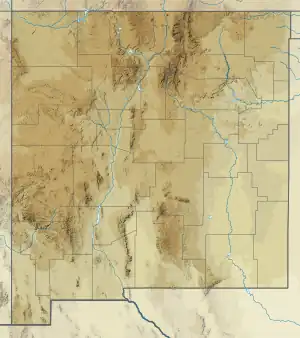| Mesilla Valley Shale | |
|---|---|
| Stratigraphic range: | |
| Type | Formation |
| Underlies | Mojado Formation |
| Overlies | Muleros Formation |
| Thickness | 210 feet (64 m) |
| Lithology | |
| Primary | Shale |
| Location | |
| Coordinates | 31°47′39″N 106°32′35″W / 31.7940792°N 106.5430513°W |
| Region | New Mexico |
| Country | United States |
| Type section | |
| Named for | Mesilla Valley |
| Named by | W.S. Strain |
| Year defined | 1976 |
 Mesilla Valley Shale (the United States)  Mesilla Valley Shale (New Mexico) | |
The Mesilla Valley Shale is a geologic formation in southern New Mexico, northern Chihuahua, and far west Texas.[1] It preserves fossils dating back to the Albian age of the early Cretaceous period.[2][3]
The formation is particularly well exposed at Cerro de Cristo Rey, near El Paso, Texas, where it is part of a thick sequence of uplifted Cretaceous beds that record transgressions (advances of the sea onto land) and regressions (retreats of the sea from the land) of the Western Interior Seaway during the mid-Cretaceous.[1]
Description
The formation consists mostly of dark green to olive clay shale[2] with some thin siltstone beds and highly fossiliferous calcareous beds.[1] It lies conformably on the Muleros Formation[3] and is conformably overlain by the Mojado Formation.[1] Total thickness is 210 feet (64 m).[3]
Lucas and his coinvestigators divide the formation into three informal members and interpret the lower two as a complete secondary deposition cycle and the upper as the base of the next deposition cycle.[4] The formation was deposited on the upper to middle continental shelf.[1]
Fossils
The formation contains at least 20 genera and 23 species of fossils. These include the molluscs Lima wacoensis Roemer, Lima mexicana Bose, Pecten texanus var. elongatus Bose, Pecten subalpinus Bose, Plicatula incongrua Conrad, Ostrea quadriplicata (Shumard), Texigryphaea washitaensis. Trigonia emery Conrad, Helicocryptus mexicanus Bose, and Turritella granulata Sowerby var. cenomanensis d'Orbigny and the echinoderm Heteraster bravoensis (Bose). These are characteristic of the Albian.[2] The formation also contains ammonoids, brachiopods, foraminiferans (especially Cribratina texana), dinoflagellates, serpulid worms, corals, ostracods, calcareous algae, and some terrestrial plant fragments.[4]
The formation also contains invertebrate trace fossils (ichnofossils), which are tracks or burrows left in the sediments. These include Ancorichnus, Arenicolites, Bergueria, Bichordites, Cardioichnus, Chondrites, Cochlichnus, Coprulus, Gordia, Helicodromites, Lockeia, Ophiomorpha, Palaeophycus, Planolites, Protovirgularia, Rhizocorallium, Skolithos, Spongeliomorpha, Taenidium, Thalassinoides, Treptichnus, and a biofilm, Rugalichnus. This diversity of trace fossils was preserved in storm deposits (tempestites) below the wave base. All are typical of the Albian, and the presence of Chondrites and other trace fossils characteristic of low oxygen conditions indicate that the trace fossils were left during an ocean anoxic event, dated to 100.6-100.2 Ma.[1]
History of investigation
The beds making up the formation were first described by E. Bose in 1906 as subdivision 6 of his stratigraphic section.[2] W.S. Strain assigned the name Mesilla Valley Shale to this subdivision in 1976.[3]
See also
Footnotes
References
- Bose, E. (1906). "Excursion au Cerro de Muleros". International Geological Congress 10, Guide for Excursion. 20.
- Kappus, Eric J.; Lucas, Spencer G. (Spring 2020). "Ichnology of the Lower Cretaceous (Albian) Mesilla Valley Formation, Cerro de Cristo Rey, southeastern New Mexico, USA" (PDF). New Mexico Geology. 42 (1): 3–30. Retrieved 1 September 2020.
- Lucas, Spencer; Krainer, Karl; Spielmann, Justin; Durney, Kevin (2010). "Cretaceous stratigraphy, paleontology, petrography, depositional environments, and cycle stratigraphy at Cerro de Cristo Rey, Doña Ana County, New Mexico". New Mexico Geology. 32: 103–130. Retrieved 5 August 2020.
- Strain, W.S. (1976). "New formation names in the Cretaceous at Cerro de Cristo Rey, Dona Ana County, New Mexico; Appendix 2" (PDF). New Mexico Bureau of Mines and Mineral Resources Memoir. 31: 77–82. Retrieved 5 August 2020.